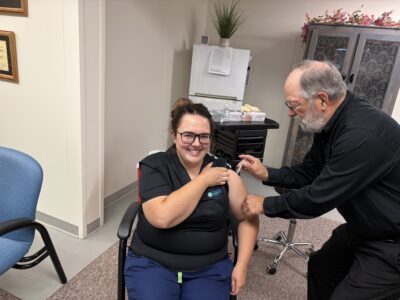State test scores vary across Northeast Michigan schools

News Photo by Julie Goldberg Besser Elementary School fourth-graders use Chromebooks on Wednesday at the school.
ALPENA — Test scores over the past five years have varied at Northeast Michigan school districts.
Each spring, third- through eighth-graders take the Michigan Student Test of Educational Progress, or M-STEP, which consists of standardized tests in reading and math for third- through eighth-graders and social studies tests for fifth- and eighth-graders. The tests are meant to gauge how well students are learning state standards and measure how well districts teach students compared to other communities.
The test scores have real consequences for students and families, too, with a new state law that says third-graders can be held back if the tests show them one or more years behind in reading.
M-STEP has been in place since spring 2015, replacing the Michigan Educational Assessment Program, or MEAP.
Compared to the 2014-15 school year, the share of students who tested proficient on reading tests were up in Hillman Community Schools, Onaway Area Community Schools, Posen Consolidated Schools, and Rogers City Area Schools. The share of proficient students was down in Alpena Public Schools, Alcona Community Schools, and Atlanta Community Schools, according to a News analysis of state data.
In that same timeframe, the share of students proficient in math increased in Atlanta, Hillman, Onaway, Posen, and Rogers City but decreased in Alpena and Alcona.
The share of students proficient in social studies increased in Alpena, Alcona, Atlanta, Hillman, and Rogers City, while falling in Onaway and Posen.
Area superintendents urged caution when making year-over-year comparisons. Some Northeast Michigan school districts have 30 or fewer students in each grade level, so, if one student performs poorly on a test one year, it can mess up proficiency rates for that entire grade level that school year.
“One or two students can have an impact in small schools,” Posen Consolidated Schools Superintendent Michelle Wesner said.
SOCIAL STUDIES
In the spring, 15% of fifth- and eighth-graders across all Northeast Michigan school districts tested proficient on the social studies test. That is down from spring 2018, when 18% of Northeast Michigan fifth- and eighth-graders tested proficient.
Because only those two grades take the social studies test each spring, it’s difficult for districts to track how well students are learning the subject, superintendents said.
Willam DiSessa, spokesman for the Michigan Department of Education, said state law requires social studies assessments once in each “grade band.” The state’s grade bands are third to fifth grade, sixth to eighth grade, and ninth to 12th grade.
Alcona Community Schools Superintendent Dan O’Connor said it’s hard to comprehend social studies scores when only two grades take the test. That makes it harder for districts to track growth, which makes it harder to know which students are struggling and need more help.
“Social studies is a subject area that has historically been lower in testing success,” Wesner, the Posen superintendent, said.
Onaway and Posen saw fewer students test proficient last spring compared to the 2014-15 school year. Onaway’s proficiency rates decreased from 28.4% in 2014-15 to 24.4% last year, while Posen’s fell from 33.3% in 2014-15 to 31.3% last year.
Those two districts were the only districts in Northeast Michigan that had a decline in proficiency.
Social studies proficiency in Alcona rose from 15.9% of students in 2014-15 and 19% proficient last year. Alpena proficiency climbed from 20.2% in 2014-15 to 32.8% last year. Atlanta had no students proficient in 2014-15 and 20.6% last year. Hillman’s proficiency climbed from 13.9% to 22.2% last year. Rogers City’s climbed from 15.7% to 21.7%.
“Students show success each year through district- and teacher-created assessments of the content area,” Wesner said.
Onaway Superintendent Rod Fullerton did not respond to messages seeking comment.
READING
Local districts focus on reading long before students start taking state tests in third grade, when a new state law says they can be held back if they don’t perform well on state tests.
Last year, 30% of Northeast Michigan third-graders were not proficient in reading.
The law requires school districts to assess kindergartners through third-grade students three times a year. Teachers use those internal scores to figure out which kids need more help.
Some districts use what officials call an intense reading intervention plan for students who are below their grade level. The plan helps the student hit reading goals so they are ready for the third-grade tests. The plans are designed along with a student’s family to make sure they’re reading outside of school, reading aloud, or being read to by someone.
“We’re closing the gap for the students,” Wesner, the Posen superintendent, said. “We’re getting started ahead so they’re not surprised when they hit third grade.”
Alpena Superintendent John VanWagoner said reading is a focus in kindergarten through second grade in his district, so students are better prepared when they hit third grade and have to take the reading test for the first time.
“It would be too late to focus on it in just third grade,” VanWagoner said.
In Alcona across all grades tested, 41.46% of students were proficient readers in 2014-15 and 41.38% were proficient last year. In Alpena, 49.55% were proficient in 2014-15 and 40.9% were proficient last year. In Atlanta, 38% were proficient in 2014-15 and 37% last year. Hillman’s proficiency rate was 32% in 2014-15 and 35.7% last year. In Onaway, 38% were proficient readers in 2014-15 and 42.9% were proficient last year. About half of Posen students were proficient in 2014-15 and 52.9% were last year. In Rogers City, 36% were proficient in 2014-15 and 49% were proficient last year.
MATH
This spring, 30.6% of Northeast Michigan students across all grades and schools tested proficient on the math tests, lower than the spring 2018 proficiency rate of 31.3%.
Posen’s test scores have been going up and down the past five years, including an increase from 32.7% of students proficiency in 2017-18 to 47.1% last school year. That happened because the district implemented a focus on interventions and daily checks to assess the student’s understanding and knowledge, Wesner said.
In Alcona, math proficiency has ranged between 20% and 30% of students for the past five years. O’Connor, the Alcona superintendent, said the district works to strengthen math scores by having a math specialist in the buildings to help students one-on-one.
Hillman and Atlanta both have direct math intervention time, which Carl Seiter, superintendent of both districts, said is helping students figure out different ways to learn, instead of just having a teacher teaching a lesson in front of students. That helped increase both districts’ math scores from the 2017-18 to 2018-19 school years.
“It’s for kids that don’t initially grasp the concept or master the concept,” Seiter said. “It’s kind of the secondary level of how are we going to get this kid to understand?”
In Alcona, 27.5% of students tested proficient in math in 2014-15 and 27.2% tested proficient last year. In Alpena, the rate was 34% in 2014-15 and 31% last year. In Atlanta, it was 15.5% in 2014-15 and 25% last year. In Hillman, 19.8% in 2014-15 and 21.8% last year. In Onaway, 45.6% in 2014-15 and 46.9% last year. In Posen, 38% of students were proficient in 2014-15 and 47.1% were proficient last year. In Rogers City, 27.4% of students were proficient in 2014-15 and 32.5% were proficient last year.
TEACHER TURNOVER
Local superintendents say teacher turnover makes it harder to build consistent test scores.
In the 2016-17 school year, 81.4% of Northeast Michigan teachers returned from the previous school year. That is the most recent data available from the state.
O’Connor said losing a teacher in a small district can mean losing the only staff member who has knowledge and practices for several grades or courses. Alcona had 82% of its teachers return in the 2016-17 school year.
Rogers City Area Schools Superintendent Nick Hein said his district has had a turnover of 12 of the 19 teachers at Rogers City Middle/High School over the past five years.
Seiter, the Hillman and Atlanta superintendent, said teachers come to Northeast Michigan to start their career and then leave for a better-paying job somewhere else.
“Just like any other occupation, teachers get better and better each year through their experience and own professional improvement,” he said. “There are so many great, young teachers who secure employment only to then begin searching for jobs in a location they want to live in.”
Wesner said Posen doesn’t have a lot of teacher turnover. In the 2016-17 school year, Posen had 84% of its teachers return.
“The classes can change the score more than anything,” Wesner said. “If you have new kids move into the district that don’t know the material the same, that can impact scores.”
HOW TO IMPROVE SCORES
School leaders said their districts work every day to improve test scores for the upcoming spring.
Wesner said teachers teach to state standards and benchmarks for each grade. That means they don’t teach to state tests.
“We combine what students need to know academically based on the guidelines set forth by the state and what we know our individual students need based on our specific geographic area,” she said.
Hein said there are curriculum meetings in Rogers City to actively improve test scores and students are given multiple opportunities to practice the tests.
“Educators attend professional development in their curriculum area to enhance their curriculum needs,” he said.
In Alcona schools, O’Connor said the district’s strategic plan has an approach that focuses on putting the best curriculum in place for students to help them get the best test scores.
Julie Goldberg can be reached at 989-358-5688 or jgoldberg@thealpenanews.com. Follow her on Twitter @jkgoldberg12.




